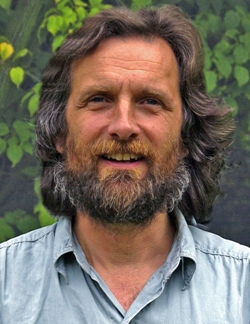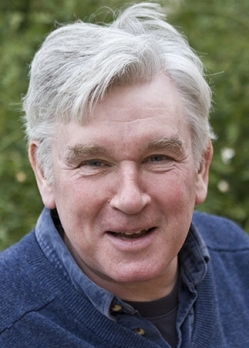Haszeldine (right) and Smythe respond to Bruce Yardley's criticisms, published here in April (see reference list for link)
 Bruce Yardley resorts to ad hominem criticism1 of our scientific views on nuclear waste disposal, accusing us of ‘campaigning’ on science matters of public interest, in contrast to scientists (himself presumably included) who dispassionately and neutrally 'advise'. However, he has evidently not taken the trouble to look out and study the highly detailed online evidence2,3 underlying our summary views4,5 concerning West Cumbria.
Bruce Yardley resorts to ad hominem criticism1 of our scientific views on nuclear waste disposal, accusing us of ‘campaigning’ on science matters of public interest, in contrast to scientists (himself presumably included) who dispassionately and neutrally 'advise'. However, he has evidently not taken the trouble to look out and study the highly detailed online evidence2,3 underlying our summary views4,5 concerning West Cumbria.
NIREX
During the 1990s Nirex undertook a national site search with BGS help, but finally targeted an inland Sellafield site which had not even featured in the working list of 537 sites6. Nirex drilled, cored, and interpreted 29 boreholes, as well as undertaking various geophysical surveys, to produce geological and hydrogeological models of the West Cumbria district, at a cost of £400M. It proved to have exceptionally fractured geology, complex hydrogeology and geochemistry. The Nirex planning inquiry of 1995-96 rejected construction of an underground test laboratory there7, recommending that alternative UK sites should be investigated8.
Reports in 1999 by the Royal Society
9 and the House of Lords Science and Technology Committee
10 recommended a national site search, led by geological criteria. However the 2001 Defra white paper Managing Radioactive Waste Safely
11 ignored this advice, proposing 'voluntarism'. CoRWM, the committee set up to develop deep geological disposal for UK intermediate and high-level radwaste, which reported in 2006, contained not a single Earth scientist.
BIASED?
 Are we partial and/or biased, according to Yardley, because our conclusions "overwhelmingly" support our case? It follows that the case for anthropogenic global warming is similarly campaign-induced, because the overwhelming majority (97%) of climate scientists accept it12. The Nirex planning inquiry inspector concluded7 that "The indications are, in my judgement, still overwhelmingly that this site is not suitable for the proposed repository, and that investigations should now be moved to one of the more promising sites elsewhere” [our emphasis]. Was he another biased ‘campaigner’?
Are we partial and/or biased, according to Yardley, because our conclusions "overwhelmingly" support our case? It follows that the case for anthropogenic global warming is similarly campaign-induced, because the overwhelming majority (97%) of climate scientists accept it12. The Nirex planning inquiry inspector concluded7 that "The indications are, in my judgement, still overwhelmingly that this site is not suitable for the proposed repository, and that investigations should now be moved to one of the more promising sites elsewhere” [our emphasis]. Was he another biased ‘campaigner’?
Yardley says that we "characterised the geology of west Cumbria as well-known, yet also so unpredictable that finding a safe repository site there was impossible" [our emphasis], implying that well-understood geology is necessarily predictable. But predictability does not necessarily arise from detailed measurement of a complex system. NASA calculated prior to the 1986 Challenger space shuttle disaster that the compound probability of failure from well-known components was one in 100,000. The real probability turned out to be more like one in ten.
Yardley makes the startling claim that the subsurface water geochemistry at west Cumbria is suitable for waste containment, based on cerium geochemistry from the PADAMOT project13. The full portfolio of evidence permits an outline reconstruction of both modern and palaeo-hydrogeology. Unsuitable oxic waters with Eh greater than +50 mV have clearly dominated to a depth of 1km, spanning all prospective repository depths. He has chosen his evidence to fit his prejudice. Yardley is an ‘agnotologist’14; one who argues that we never know enough; 'we do not yet have enough data' – much like climate sceptics and in earlier times, apologists for big tobacco15,16.
Our full technical response to Yardley is available online2,3.
Further reading
- Yardley, B. 2013. Of advice and lobbying. Geoscientist 23, 9.
- http://www.geos.ed.ac.uk/homes/rsh
- http://www.davidsmythe.org/nuclear/nuclear.htm
- Evidence to Cumbria MP’s fact finding inquiry 10 January 2013: R.S. Haszeldine, DK Smythe http://www.geos.ed.ac.uk/homes/rsh/CumbriaMPradwastefactfind.html
- Final comments by Professors Smythe and Haszeldine to the DMBs ahead of the 30 January decisions. D. K. Smythe, R. S.Haszeldine https://www.geos.ed.ac.uk/homes/rsh/Cumbria_Allerdale_Copeland_evi/Cumbria_Sellafield_GDF_Radwaste_Final_comments_by_Smythe_Haszeldine_27Jan13.pdf
- PIEDA initial list of 537 sites. Available at: http://www.davidsmythe.org/nuclear/nuclear.htm
- Haszeldine, R. S. and Smythe, D. K. 1997. Why was Sellafield rejected as a site for radioactive waste ? Geoscientist, 7, 18-20. http://www.geos.ed.ac.uk/research/subsurface/diagenesis/Why_was_sellafield_rejected_as_a_disposal_site_for_radioactive_waste_1997_haszeldine_smythe_geoscientist_1997.pdf
- McDonald, C. S. 1996. Inspector’s Report. Cumbria County Council; Appeal by UK Nirex Limited. Inquiry document no. APP/H0900/A/94/247019. Available at http://www.geos.ed.ac.uk/homes/rsh/Cumbria_Allerdale_Copeland_evi/
- The Royal Society 1999. Nuclear energy - the future climate. Available at: http://royalsociety.org/policy/publications/?year=1999&type=reports-statements
- House of Lords Science and Technology Third Report 1999 (on management of nuclear waste). Pdf version available at: http://www.davidsmythe.org/nuclear/documents.htm
- Defra 2001. Managing radioactive waste safely. White paper, September 2001. Available at: http://www.davidsmythe.org/nuclear/documents.htm
- Cook, J. et al. 2013. Quantifying the consensus on anthropogenic warming in the scientific literature. Environ. Res. Lett. 8, 024024. http://iopscience.iop.org/1748-9326/8/2/024024/article
- 2005 PADAMOT Palaeohydrogeological Data Analysis and Model testing. http://www.bgs.ac.uk/padamot/docs/PADAMOT_OVERVIEW_REPORT_v7_2.pdf
- https://en.wikipedia.org/wiki/Agnotology.
- Michaels, D. 2008. Doubt is their product. Oxford University Press.
- Oreskes, N. and Conway, E. M. 2010 Merchants of doubt. Bloomsbury Press.